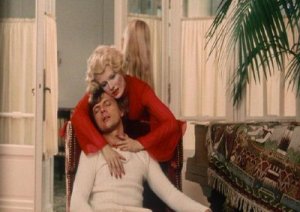
The beautiful Delphine Seyrig stars as the bloodthirsty Countess Báthory in Harry Kümel's "Daughters of Darkness" (1971).
1. The stylish Daughters of Darkness (1971) from Belgian director Harry Kümel continues to be one of my favourite indulgences when it comes to eurotrash vampire films. I’ve already dedicated an entire blog post on Kümel’s film, but a recently discovered quote from “dissident feminist” Camille Paglia has reminded me of my great admiration for this lesbian-vampire classic:
“A classy genre of vampire film follows a style I call psychological high Gothic. […] A good example is Daughters of Darkness, starring Delphine Seyrig as an elegant lesbian vampire. High gothic is abstract and ceremonious. Evil has become world-weary, hierarchical glamour. There is no bestiality. The theme is eroticized western power, the burden of history.”
— Camille Paglia, Sexual Personae: Art and Decadence from Nefertiti to Emily Dickinson. Yale University Press, 1990, p. 268.
2. Yet another Belgian vampire film, although the ‘found-footage’ hand-held camera-style of Vincent Lannoo’s Vampires (2011) could scarcely be more of a departure from Kümel’s meticulously crafted film. Touted in the media as “Spinal Tap meets the Munsters”, Lannoo’s mockumentary delves into the culture of contemporary Belgian vampires, all with a wonderfully deadpan, blacker-than-night sense of humour. After several unsuccessful attempts to document the vampire community — as the film crews kept, um, getting eaten — the crew that purportedly filmed Vampires manage to locate an amenable vampire family that allow them to document their daily routines. Even though the found-footage schtick has grown very, very tired in the horror genre, I found myself enjoying the detailed accounts of vampire customs and culture.
3. The low-budget indie film Habit (1999) was written, produced, directed, and edited by genre fave Larry Fessenden. This is a grungy and unglamorous revisionist-vampire film that uses vampirism as a metaphor for addiction. Fessenden plays Sam, a world-weary bartender who struggles with alcoholism and the recent death of his estranged father. When Sam meets the mysterious Anna at a friend’s party, things eventually go from bad to worse. While this film offers little in terms of fanged neck-biting, it has an effectively moody atmosphere and some fairly erotic sex scenes.
4. Cronos (1993), written & directed by Guillermo del Toro, was the cinematic debut of the Mexican filmmaker better known for his later film Pan’s Labyrinth. A fairly unique treatment of the vampire mythology in which an ancient and mysterious mechanical device is used to transmit the virus of vampirism. An old antique dealer unwittingly discovers the scarab-shaped device in his shop and becomes infected. Fans of del Toro’s work will recognize his characteristic black humour and fondness for grotesquery.

The priest Sang-hyun saves his dying love interest Tae-ju by rendering her a vampire in "Thirst" (2009).
5. Another clever twist on the vampire legend is Chan-wook Park’s Thirst (2009). Sang-hyun is a devout Catholic priest who, for all intents and purposes, opts to martyr himself by subjecting his body to some radical medical experiments. When these medical experiments result in vampirism, the priest wrestles not only with a heightened desire for carnality, but also a thirst for human blood.





